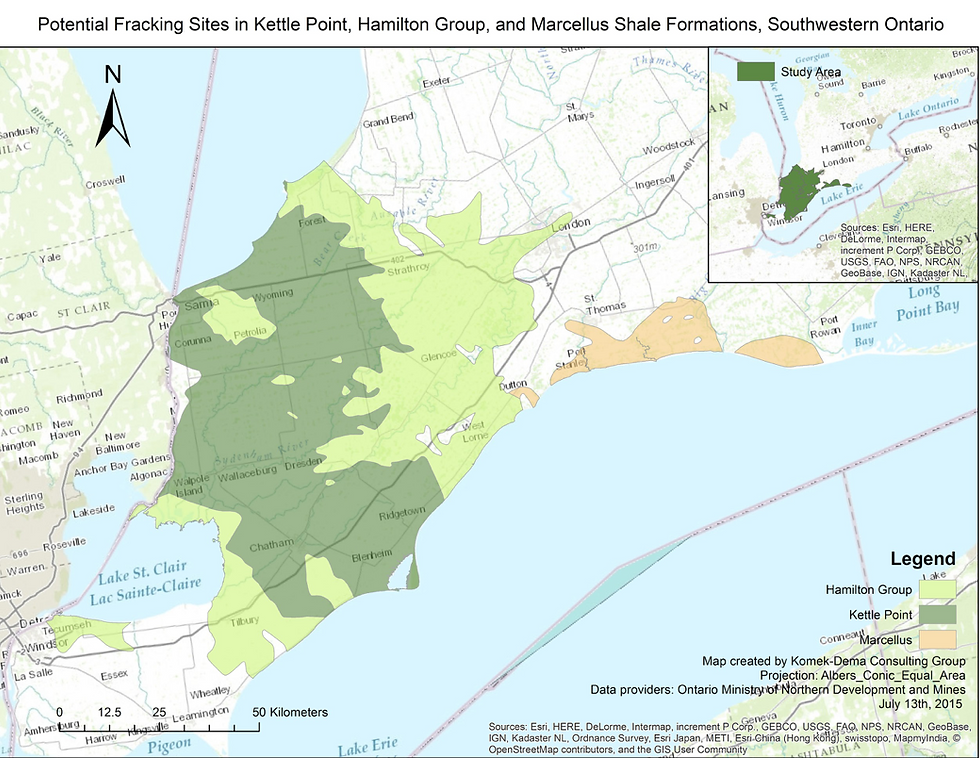Fracking the Southern Ontario Shale
- Ana M. Koterniak
- Mar 26, 2016
- 7 min read
In modern advanced economies, the recent increase in technology and population is creating a large demand for energy. The U.S. Energy Information Administration (2013) projects the consumption of energy to increase by over 50%. Fossil fuel resources have steadily become an integral part of this energy demand, accounting for approximately 75% of anthropogenic emissions since 1994 (United States Department of Energy, 2013). As world population grows and the demand for both increased food security and economic development expands, there has been increased exploitation of these fossil fuels. Horizontal fracturing of geologic shale deposits has recently become an economically viable alternative to conventional oil drilling. Previously too costly to produce, it is now presented by fossil fuel advocates as a cleaner alternative to oil and coal. However, clean energy advocates question the link from fracking on environmental and human impacts and whether the practice should continue in light of alternative renewable energy sources.
Documented Impacts and Concerns
To maintain open fractures, an injection of high pressurized fracking fluid containing acids, corrosive inhibitors, and chemical additives is added into the ground (Maule, Makey, Benson, Burrows, & Scammell, 2013). Stokstad (2014) found that fracking operations use an average of 15 to 30 million litres of pressurized water to fracture shale; 10 to 100 times the amount required for a conventional vertical gas well. Howarth, Ingraffea and Engelder (2011) concluded that about one fifth of fracking fluid flows back up the well over the course of its lifetime, amounting to up to 30,000 litres. Schmidt (2013) and Stokstad (2014) further add that natural salts, heavy metals, hydrocarbons, radioactive materials, and volatile organic compounds (VOCs) move back up the well with contaminated wastewater. These fluids or gases may escape which may be a source of contamination. Methane stored in these shale deposits is particularly concerning, as its greenhouse gas potential is 25 times the effect of one unit of carbon dioxide over a 100 year period (Howarth, Ingraffea, & Engelder, 2011; United States Environmental Protection Agency, 2010). Although the prevention of gas and fluid emissions have been argued to be effective, Schmidt and Stokstad (2013, 2014) state that sewage treatment plants are often not able to deal with the volume of waste fluids, often leading to incorrect disposal on the order of millions of litres. New methods of disposal are used to reduce the increasing amounts of water being delivered to treatment plants. Underground injection is a more common method used for wastewater disposal, however, it has also been linked to increased earthquake activity (United States Environmental Protection Agency, 2012; Schmidt, 2013; Ellsworth, 2013). Twelve minor earthquakes in the Ohio area were linked to underground injection of wastewater, after having quadrupled the amount of imported wastewater to 400 million litres in 2011 (Schmidt, 2013).
Contaminated wastewater and potentially contaminated groundwater bring forward concern as the associated pollutants and the potential for air emissions leave people worried about potential human health risks from air emissions, contaminated drinking water and food (Gordalla, Ewers, & Frimmel, 2013; Mitka, 2012; Rahm, 2011). Jenner and Lamadrid (2013) also discovered that accumulated sludge from the wells can have naturally occurring radioactive materials, which may be released with wastewater. A study conducted on the list of possible chemicals used during fracking outlined that more than 75% of these can affect the skin, eyes, respiratory and gastrointestinal systems; 40 to 50% could affect the central nervous system, the kidneys, immune and cardiovascular systems; 37% could affect the endocrine system; and 25% are cancerous and mutagenic. Most chemicals used for fracking can cause 6 to 14 different adverse health effects (Colborn, 2011).
[full report can be obtained by contacting the author of this blog]
Kettle Point, Hamilton Group, and Marcellus shale formations in Southwestern Ontario cover an area of approximately 7900 square kilometers at an elevation of 169 to 390 meters above sea level.

The research conducted in this report was aimed at determining which sites in the Southern Ontario Shale will be relatively suitable for fracking activities, both in regard to environmental protection and economic viability. Thus the following geospatial analysis will determine location of areas that are a sufficient distance away from environmentally sensitive areas, groundwater, and population centres, yet close enough to major roadways.
[full report including detailed methodology and data can be obtained by contacting the author of this blog]
Analysis
Prior to analyzing fracking site suitability, a map of major areas of exclusion was developed. The output of this process was a refined area of analysis for both models, removing First Nations Reserves, wetlands, and populated or urban areas. Wetlands may theoretically be fracked, however companies do not typically pursue development in this land due to risk negative publicity and environmental concern. Although fracking could be allowed in a First Nations reserve, many First Nations communities have banned the practice on their land in the United States, thus it is expected that the Aboriginal communities in Ontario will take a similar approach should development be proposed (Blohm, Peichel, Smith, & Kougentakis, 2012).

Environmentally sensitive areas were determined based on distance to groundwater, protected natural habitats, wetlands (the closer the more sensitive), and soil type (certain soil types more prone to causing erosion and chemical leakage).

In addition to the areas of exclusion based on presence of population centres and First Nation communities, all land within 805 metre of all water wells must be excluded in accordance with predicted regulatory constraints applied and similar to results obtained in Blohm et al. (2012). The degree of suitability in the remaining areas is based on environmental sensitivity determined above.

[full report can be obtained by contacting the author of this blog]
The municipalities containing the most significant proportions of suitable areas are located in Plympton-Wyoming, Warwick, Enniskillen, Dutton/Dunwich, Chatham-Kent and Lakeshore. Areas of suitability within one standard deviation span 4 to 10 km2; areas within two standard deviations cover as much as 30 km2, while areas within three standard deviations span out to as much as 170 km2 coverage.

Chatham-Kent contains another large cluster of suitable land for no-conflict fracking, but with a much higher population than Enniskillen, Warwick and Plympton-Wyoming of over 100,000 people. Chatham-Kent, situated on the Lower Thames watershed, shows less overlay with major hydrology, but similar to the Ausable watershed there are regulations in place for developments that are hazardous or alter hydrology (Lower Thames Conservation Authority, 2015). It may be concluded that fracking is less suitable within a human-impact context in the Lower Thames watershed due to the relatively higher population.
A particularly high density of fracking suitable locations were found to be concentrated around Petrolia and Enniskillen. Petrolia has a history of high industrialization; it was billed as ‘Canada’s Victorian Oil Town’ and credited with starting the oil industry in North America (Fairbank, 1908). Both CDAs have a population of under 5000 people, making it less likely that significant amounts of people will be affected or complain about the outlined side effects of hydraulic fracturing, as well as reducing the total amount of people impacted by any fracking operations. High concentration of areas suitable for fracking also overlays Plympton Wyoming, and Warwick, the two CDAs have similarly low populations, which reduces the magnitude of potential risk to humans.
Because Plympton Wyoming, Warwick and Enniskillen are part of the Kettle Point shale formations have overlying till with low permeability and permeable bedrock they are excellent sources for gas removal. Due to these considerations, the municipalities may be inclined to introduce new development for economic benefit. Nonetheless, the highly sensitive environmental areas are precariously close to the three CDAs. In addition, Plympton Wyoming, Warwick and Enniskillen are part of the Ausable and Sydenham Watersheds, where all new developments which may alter waterways or are potentially hazardous need to undergo approval (Ausable Bayfield Conservation Authority (ABCA), 2015). ABCA (2015) further outlines that if the development is approved, the corresponding watershed conservation authority will require certain steps to be taken to minimize risk to environmentally sensitive zones and the community.
Conclusion
Exploring potential impacts of hydraulic fracturing is a pressing issue as Southern Ontario’s Kettle Point, Marcellus Shale, and Hamilton Group contain leased land that is intended to be used for shale gas extraction through fracking. GIS based suitability analysis addressed potential environmental sensitivity of the study site. To create a financial incentive for leaseholders to frack in suggested sites, economic suitability based on criteria such as convenient distance to roads and water supply was analysed as demonstrated in the produced maps. Review of literature suggested that a high concentration of area within Southwestern Ontario would be unsuitable for fracking due to the numerous environmental constraints, each with a certain setback or constraint (Baranzelli et al., 2015; Blohm et al., 2012). These regulated setback distances were found to have significantly reduced the total area for suitable fracking sites, with water wells restricting the largest amount of land. A high amount of land-use suitability for environmentally sensitive land was found throughout the majority of the study area, directly translating into a high influence on reducing the amount of land both economically and environmentally suitable for fracking.
Though our study area covers a large area, from the resulting analysis, it can be concluded that within the Southwestern Ontario study area, fracking has relatively limited suitable areas that come into no or little conflict with an area of exclusion or an environmentally sensitive area. Nonetheless, these limited areas are still large enough to allow significant shale gas extraction operations.
The results from this study will work to provide insight into suitable lands for fracking in Southwestern Ontario. Fracking companies will be able to use this information to decide which areas will minimize legal conflicts and conflicts with environmentally sensitive land. Moreover, this study can also work as a guideline for other potential fracking designers to analyze and decide where the suitable areas for fracking are in their leased lands. Additionally, the study can also help fracking companies and other industry fields develop responsible environmental management principles when they select their potential sites.







Comments